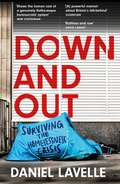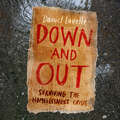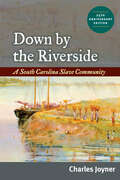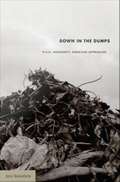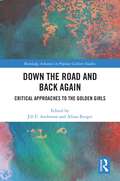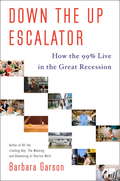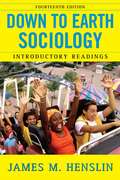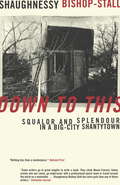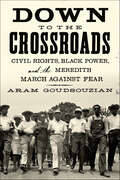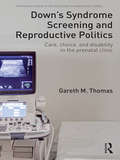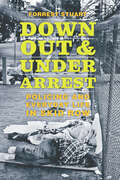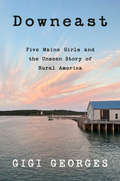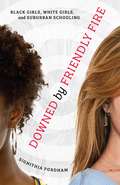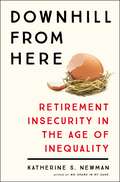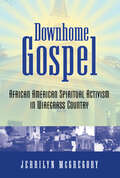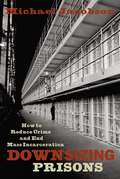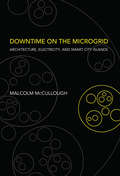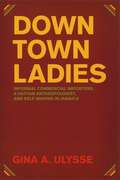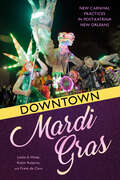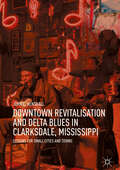- Table View
- List View
Down and Out: Surviving the Homelessness Crisis
by Daniel Lavelle'Lavelle's ruthless and raw exposé fills me with rage, but also with hope - underneath this harrowing story of injustice lies a lyrical longing for a more compassionate and caring future' DAVID LAMMYAt once a powerful memoir, unflinching polemic and probing investigation into modern homelessness in the UK, by award-winning investigative journalist Daniel LavelleDaniel Lavelle left care at the age of nineteen, and experienced homelessness for the first time not long after. So began a life spent navigating social services that were not fit for purpose, leaving Daniel and many like him slipping through the cracks.In Down and Out, Daniel draws on his own experiences - as well as those of the witty, complex, hopeful individuals he has encountered who have been shunned or forgotten by the state that is supposed to provide for them - in order to shine a powerful light on this dire situation. Down and Out is a true state-of-the-nation examination of modern homelessness: assessing its significance, its precursors and causes, as well as the role played by government, austerity, charities, and other systems in perpetuating this crisis. Ultimately, it seeks to ask how we as a society might change our practices and attitudes so that, one day, we can bring this injustice to an end.More praise for Down and Out:'Lavelle is a vital voice on one of the most pressing scandals facing Britain today. A book for every politician, policy maker and reader who wants a fairer and kinder country' FRANCES RYAN, author of CRIPPLED
Down and Out: Surviving the Homelessness Crisis
by Daniel Lavelle'Lavelle's ruthless and raw exposé fills me with rage, but also with hope - underneath this harrowing story of injustice lies a lyrical longing for a more compassionate and caring future' DAVID LAMMYAt once a powerful memoir, unflinching polemic and probing investigation into modern homelessness in the UK, by award-winning investigative journalist Daniel LavelleDaniel Lavelle left care at the age of nineteen, and experienced homelessness for the first time not long after. So began a life spent navigating social services that were not fit for purpose, leaving Daniel and many like him slipping through the cracks.In Down and Out, Daniel draws on his own experiences - as well as those of the witty, complex, hopeful individuals he has encountered who have been shunned or forgotten by the state that is supposed to provide for them - in order to shine a powerful light on this dire situation. Down and Out is a true state-of-the-nation examination of modern homelessness: assessing its significance, its precursors and causes, as well as the role played by government, austerity, charities, and other systems in perpetuating this crisis. Ultimately, it seeks to ask how we as a society might change our practices and attitudes so that, one day, we can bring this injustice to an end.More praise for Down and Out:'Lavelle is a vital voice on one of the most pressing scandals facing Britain today. A book for every politician, policy maker and reader who wants a fairer and kinder country' FRANCES RYAN, author of CRIPPLED
Down and Out: Surviving the Homelessness Crisis
by Daniel Lavelle'When I zipped up my tent on that first night sleeping rough, I felt no despair... I was just another care leaver who had lost control of his life.'As a care-leaver who has experienced homelessness, award-winning investigative journalist Daniel Lavelle has spent his life navigating social services that are not fit for purpose and leave many vulnerable people slipping through the cracks. For though the right to adequate housing is enshrined in the Universal Declaration of Human Rights, the reality is another, much grimmer, story.In Down and Out, Daniel draws on his own experiences, as well as those of the witty, complex, hopeful individuals he has encountered who have been shunned or forgotten by the state that is supposed to provide for them, in order to shine a powerful light on this world. Down and Out is a true state-of-the-nation examination of modern homelessness, assessing its significance, its precursors and causes, as well as the role played by government, austerity, charities, and other systems in perpetuating this crisis. Ultimately, it seeks to ask how we as a society might change our practices and attitudes so that one day we might bring it to an end.(P) 2022 Headline Publishing Group Ltd
Down by the Riverside: A South Carolina Slave Community (Blacks in the New World)
by Charles JoynerIn Down by the Riverside, Charles Joyner takes readers on a journey back in time, up the Waccamaw River through the Lowcountry of South Carolina, past abandoned rice fields once made productive by the labor of enslaved Africans, past rice mills and forest clearings into the antebellum world of All Saints Parish. In this slave community, and many others like it, the slaves created a new language, a new religion--indeed, a new culture--from African traditions and American circumstances. From the letters, diaries, and memoirs of the plantation whites and their guests, from quantitative analysis of census and probate records, and above all from slave folklore and oral history, Joyner has recovered an entire society and its way of life. His careful reconstruction of daily life in All Saints Parish is an inspiring testimony to the ingenuity and solidarity of a people who endured in the face of adversity. This anniversary edition of Joyner's landmark study includes a new introduction in which the author recounts his process of writing the book, reflects on its critical and popular reception, and surveys the path of scholarship in slave history in the decades since the book's first publication.
Down in the Dumps: Place, Modernity, American Depression
by Jani ScanduraMucking around in the messy terrain of American trash, Jani Scandura tells the story of the United States during the Great Depression through evocative and photo-rich portraits of four locales: Reno, Key West, Harlem, and Hollywood. In investigating these Depression-era "dumps," places that she claims contained and reclaimed the cultural, ideological, and material refuse of modern America, Scandura introduces the concept of "depressive modernity," an enduring affective component of American culture that exposes itself at those moments when the foundational myths of America and progressive modernity--capitalism, democracy, individualism, secularism, utopian aspiration--are thrown into question. Depressive modernity is modernity at a standstill. Such a modernity is not stagnant or fixed, nor immobile, but is constituted by an instantaneous unstaging of desire, territory, language, and memory that reveals itself in the shimmering of place. An interpretive bricolage that draws on an unlikely archive of 1930s detritus--office memos, scribbled manuscripts, scrapbooks, ruined photographs, newspaper clippings, glass eyes, incinerated stage sets, pulp novels, and junk washed ashore--Down in the Dumps escorts its readers through Reno's divorce factory of the 1930s, where couples from across the United States came to quickly dissolve matrimonial bonds; Key West's multilingual salvage economy and its status as the island that became the center of an ideological tug-of-war between the American New Deal government and a politically fraught Caribbean; post-Renaissance Harlem, in the process of memorializing, remembering, grieving, and rewriting a modernity that had already passed; and Studio-era Hollywood, Nathanael West's "dump of dreams," in which the introduction of sound in film and shifts in art direction began to transform how Americans understood place-making and even being itself. A coda on Alcatraz and the Pentagon brings the book into the present, exploring how American Depression comes to bear on post-9/11 America.
Down the Road and Back Again: Critical Approaches to The Golden Girls (Routledge Advances in Popular Culture Studies)
by Alissa Burger Jill E. AndersonThis is the first book‑length study of The Golden Girls, which ran for seven award‑winning seasons from 1985 to 1992 and produced two spin-offs.Through a cultural studies approach, this collection examines a wide range of topics, including race, sexuality, queerness, memory, familial mythmaking, aging, health, and financial precarity. Featuring contributions from an international team of scholars, this book highlights the enduring relevance and cultural impact of the show, even 30 years after its original airing.Offering fresh insights into its cross‑generational and cross‑cultural appeal, Down the Road and Back Again is intended for scholars of pop culture and fans of the show.
Down the Up Escalator
by Barbara GarsonOne of our most incisive and committed journalists--author of the classic All the Livelong Day--shows us the real human cost of our economic follies. The Great Recession has thrown huge economic challenges at almost all Americans save the super-affluent few, and we are only now beginning to reckon up the human toll it is taking. Down the Up Escalator is an urgent dispatch from the front lines of our vast collective struggle to keep our heads above water and maybe even--someday--get ahead. Garson has interviewed an economically and geographically wide variety of Americans to show the painful waste in all this loss and insecurity, and describe how individuals are coping. Her broader historical focus, though, is on the causes and consequences of the long stagnation of wages and how it has resulted in an increasingly desperate reliance on credit and a series of ever-larger bubbles--stocks, technology, real estate. This is no way to run an economy, or a democracy. From the members of the Pink Slip Club in New York, to a California home health-care aide on the eve of eviction, to a subprime mortgage broker who still thinks it could have worked, Down the Up Escalator presents a sobering picture of what happens to a society when it becomes economically organized to benefit only the very rich and the quick-buck speculators. But it also demonstrates the wit and resilience of ordinary Americans--and why they deserve so much better than the hand they've been dealt.
Down to Earth Sociology, 14th Edition
by James M. HenslinFor thirty-five years and through thirteen editions, Jim Henslin's Down to Earth Sociology has opened new windows onto the social realities that shape our world. Now in its fourteenth edition, the most popular anthology in sociology includes new articles on our changing world while also retaining its classic must-read essays. Focusing on social interaction in everyday life, the forty-six selections bring students face-to-face with the twin projects of contemporary sociology: understanding the individual's experience of society and analyzing social structure. The fourteenth edition's exceptional new readings include selections on the role of sympathy in everyday life, mistaken perceptions of the American family, the effects of a criminal record on getting a job, and the major social trends affecting our future. Together with these essential new articles, the selections by Peter Berger, Herbert Gans, Erving Goffman, Donna Eder, Zella Luria, C. Wright Mills, Deborah Tannen, Barrie Thorne, Sidney Katz, Philip Zimbardo, and many others provide firsthand reporting that gives students a sense of "being there." Henslin also explains basic methods of social research, providing insight into how sociologists explore the social world. The selections in Down to Earth Sociology highlight the most significant themes of contemporary sociology, ranging from the sociology of gender, power, politics, and religion to the contemporary crises of racial tension, crime, rape, poverty, and homelessness.
Down to This: A Year Living with the Homeless
by Shaughnessy Bishop-StallFor some young men, climbing Everest or sailing solo into polar seas isn't the biggest risk in the world. Instead it is venturing alone into the deepest urban jungle, where human nature is the dangerous, incomprehensible and sometimes wildly uplifting force that tests not only your ability to survive but also your own humanity. One cold November day, Shaughnessy Bishop-Stall heads out on just such a quest. He packs up a new tent, some clothes, his notebooks and a pen and goes to live in Tent City, twenty-seven lawless acres where the largest hobo town on the continent squats in the scandalized shadow of Canada's largest city. The rules he sets for himself are simple: no access to money, family or friends, except what he can find from that day on. He'll do whatever people in Tent City do to get by, be whatever bum, wino, beggar, hustler, criminal, junkie or con man he chooses to be on any given day. When he arrives, he finds a dump full of the castaways of the last millennium, human and otherwise. On the edge of the world, yet somehow smack in the middle of it all, fugitives, drug addicts, prostitutes, dealers and ex-cons have created an anarchic society, where the rules are made up nightly and your life depends on knowing them. Not only does Bishop-Stall manage to survive until the bulldozers come, but against all odds his own heart and spirit slowly mend. An astonishing account of birth, suicide, brawls, binges, tears, crazed laughter, good and bad intentions, fiendish charity and the sudden eloquence and generosity of broken souls, Down to This is Bishop-Stall's iridescent love song to a lost city like no other.
Down to the Crossroads: Civil Rights, Black Power, and the Meredith March Against Fear
by Aram GoudsouzianIn 1962, James Meredith became a civil rights hero when he enrolled as the first African American student at the University of Mississippi. Four years later, he would make the news again when he reentered Mississippi, on foot. His plan was to walk from Memphis to Jackson, leading a "March Against Fear" that would promote black voter registration and defy the entrenched racism of the region. But on the march's second day, he was shot by a mysterious gunman, a moment captured in a harrowing and now iconic photograph. What followed was one of the central dramas of the civil rights era. With Meredith in the hospital, the leading figures of the civil rights movement flew to Mississippi to carry on his effort. They quickly found themselves confronting southern law enforcement officials, local activists, and one another. In the span of only three weeks, Martin Luther King, Jr., narrowly escaped a vicious mob attack; protesters were teargassed by state police; Lyndon Johnson refused to intervene; and the charismatic young activist Stokely Carmichael first led the chant that would define a new kind of civil rights movement: Black Power. Aram Goudsouzian's Down to the Crossroads is the story of the last great march of the King era, and the first great showdown of the turbulent years that followed. Depicting rural demonstrators' courage and the impassioned debates among movement leaders, Goudsouzian reveals the legacy of an event that would both integrate African Americans into the political system and inspire even bolder protests against it. Full of drama and contemporary resonances, this book is civil rights history at its best.
Down with Childhood: Pop Music and the Crisis of Innocence
by Paul RekretSometimes popular music registers our concerns and anxieties more lucidly than we realise. This is evident in the case of an ideal of childhood innocence in rapid decay in recent decades.So claims Down with Childhood, as it takes in psychedelia’s preoccupation with rebirth and inner-children, the fascination with juvenilia amidst an ebbing UK rave scene and dozens of nursery rhyme hip-hop choruses spawned by a hit Jay-Z tune.As it examines the often complex sets of meanings to which the occasional presence of children in pop songs attests, the book pauses at Musical Youth’s ‘Pass the Dutchie’ and other one-hit teen wonders, the career paths of child stars including Michael Jackson and Britney Spears, radical experiments in free jazz, and Black Panther influenced children’s soul groups.In the process, a novel argument begins to emerge relating the often remarked crisis of childhood to changing experiences of work and play and ultimately, to an ongoing capitalist crisis that underlies them.
Down's Syndrome Screening and Reproductive Politics: Care, Choice, and Disability in the Prenatal Clinic
by Gareth M. ThomasNominated for the Foundation of Sociology of Health and Illness Book Prize 2018 In the UK and beyond, Down’s syndrome screening has become a universal programme in prenatal care. But why does screening persist, particularly in light of research that highlights pregnant women’s ambivalent and problematic experiences with it? Drawing on an ethnography of Down’s syndrome screening in two UK clinics, Thomas explores how and why we are so invested in this practice and what effects this has on those involved. Informed by theoretical approaches that privilege the mundane and micro practices, discourses, materials, and rituals of everyday life, Down’s Syndrome Screening and Reproductive Politics describes the banal world of the clinic and, in particular, the professionals contained within it who are responsible for delivering this programme. In so doing, it illustrates how Down’s syndrome screening is ‘downgraded’ and subsequently stabilised as a ‘routine’ part of a pregnancy. Further, the book captures how this routinisation is deepened by a systematic, but subtle, framing of Down’s syndrome as a negative pregnancy outcome. By unpacking the complex relationships between professionals, parents, technology, policy, and clinical practice, Thomas identifies how and why screening is successfully routinised and how it is embroiled in both new and familiar debates surrounding pregnancy, ethics, choice, diagnosis, care, disability, and parenthood. The book will appeal to academics, students, and professionals interested in medical sociology, medical anthropology, science and technology studies (STS), bioethics, genetics, and/or disability studies.
Down, Out, and Under Arrest: Policing and Everyday Life in Skid Row
by Forrest StuartIn his first year working in Los Angeles's Skid Row, Forrest Stuart was stopped on the street by police fourteen times. Usually for doing little more than standing there. Juliette, a woman he met during that time, has been stopped by police well over one hundred times, arrested upward of sixty times, and has given up more than a year of her life serving week-long jail sentences. Her most common crime? Simply sitting on the sidewalk--an arrestable offense in LA. Why? What purpose did those arrests serve, for society or for Juliette? How did we reach a point where we've cut support for our poorest citizens, yet are spending ever more on policing and prisons? That's the complicated, maddening story that Stuart tells in Down, Out and Under Arrest, a close-up look at the hows and whys of policing poverty in the contemporary United States. What emerges from Stuart's years of fieldwork--not only with Skid Row residents, but with the police charged with managing them--is a tragedy built on mistakes and misplaced priorities more than on heroes and villains. He reveals a situation where a lot of people on both sides of this issue are genuinely trying to do the right thing, yet often come up short. Sometimes, in ways that do serious harm. At a time when distrust between police and the residents of disadvantaged neighborhoods has never been higher, Stuart's book helps us see where we've gone wrong, and what steps we could take to begin to change the lives of our poorest citizens--and ultimately our society itself--for the better.
Downeast: Five Maine Girls and the Unseen Story of Rural America
by Gigi GeorgesA touching four-year chronicle of five girls coming of age in impoverished rural Maine and learning to forge their own paths through life’s struggles.“Remarkably poignant and timely . . . should be read by anyone who cares to understand rural America’s human tragedies and heroic triumphs.” —John J. Dilulio, Jr.Nestled in Maine’s far northeast corner, Washington County sits an hour’s drive from the heart of famed and bustling Acadia National Park. Yet it’s a world away. For Willow, Vivian, McKenna, Audrey, and Josie—five teenage girls caught between tradition and transformation in this remote region—it’s home. Based on four years of intimate reporting, Downeast follows their journeys of heartbreak and hope in uncertain times, creating a nuanced and unique portrait of small-town life with women at its center. It crafts a powerful and optimistic counternarrative to the dominant downbeat stories about rural America as a place of hopelessness and despair.All five girls know the pain and joy of life in a region whose rugged beauty and stoicism mask dwindling populations, vanishing job opportunities, and pervasive opioid addiction. As the girls reach adulthood, they discover that despite significant challenges, there is much to celebrate in “the valley of the overlooked.”Their stories remind us of the value of timeless ideals: strength of family and community, resilience in the face of hurdles, reverence for nature’s rule, dignity in cracked hands and muddied shoes, and the enduring power of home.“A remarkable book. . . . Downeast is important, arresting, and engrossing.” —Christina Baker Kline, #1 New York Times–bestselling author“It’s almost impossible not to care about these fierce young women and cheer for their hard-won successes.” —Kirkus Reviews“Well-researched and compelling . . . a celebration of hard work rewarded and family connections cherished. It is not in any way saccharine, but it is a welcome dose of positivity in a troubled time.” —Portland Press Herald
Downeast: Five Maine Girls and the Unseen Story of Rural America
by Gigi GeorgesBased on four years of reporting, “a heartfelt portrait of five teenage girls growing up in Maine’s remote and economically depressed Washington County” (Publishers Weekly).Downeast follows five girls as they come of age in one of the most challenging and geographically isolated regions on the Eastern seaboard. Nestled in Maine’s far northeast corner, Washington County sits an hour’s drive from the famed Acadia National Park. Yet it’s a world away. For Willow, Vivian, Mckenna, Audrey, and Josie—five teenagers caught between tradition and transformation in this remote region—it is home. Gigi Georges traces their journeys of heartbreak and hope in uncertain times, creating a nuanced portrait of rural America with women at its center.Willow lives in the shadow of an abusive, drug-addicted father and searches for stability through photography and love. Vivian, a gifted writer, feels stifled by her church and town, and struggles to break free without severing family ties. Mckenna is a softball pitching phenom whose passion is the lobster-fishing she learned at her father’s knee. Audrey is a beloved basketball star who earns a coveted college scholarship but questions her chosen path. Josie, a Yale-bound valedictorian, is determined to take the world by storm. All five know the pain and joy of life in a region whose rugged beauty and stoicism mask dwindling populations, vanishing job opportunities, and pervasive opioid addiction. As the girls reach adulthood, they discover that despite significant challenges, there is much to celebrate in “the valley of the overlooked.” Their stories remind us of the value of timeless ideals: strength of family and community, reverence for nature’s rule, dignity in cracked hands and muddied shoes, and the enduring power of home.“[A] remarkable book . . . important, arresting, and engrossing.”—Christina Baker Kline, #1 New York Times–bestselling author of Orphan Train
Downed by Friendly Fire: Black Girls, White Girls, and Suburban Schooling
by Signithia FordhamMost Americans would never willingly revisit their high school experiences; the nation&’s school systems reflect the broader society&’s hierarchical emphasis on race, class, and gender. While schools purport to provide equal opportunities for all students, this rarely happens in actuality—particularly for girls. In Downed by Friendly Fire, Signithia Fordham unmasks and examines female-centered bullying in schools, arguing that it is essential to unmask female aggression, bullying, and competition, all of which directly relate to the structural violence embedded in the racialized and gendered social order. For two and a half years, Fordham conducted field research at &“Underground Railroad High School,&” a suburban high school in upstate New York. Through a series of composite student profiles, she examines the girls&’ relationships to academic achievement, social competition, and aggression toward one another. Fordham argues that girls academically &“compete to lose,&” which only perpetuates their subordination through the misrecognition of their own competitive behaviors. She goes further to expand the meaning of violence to include what is seen as normal, including suffering, humiliation, and social and economic abuse. Using the concept &“symbolic violence,&” Fordham theorizes the psychological and social damage suffered especially by black girls in schools. The five narratives in Downed by Friendly Fire ultimately highlight the pain and suffering this violence produces as well as the ways in which it promotes inequality, exclusion, and marginalization among girls.
Downhill from Here: Retirement Insecurity in the Age of Inequality
by Katherine S. NewmanA sharp examination of the looming financial catastrophe of retirement in America.As millions of Baby Boomers reach their golden years, the state of retirement in America is little short of a disaster. Nearly half the households with people aged 55 and older have no retirement savings at all. The real estate crash wiped out much of the home equity that millions were counting on to support their retirement. And the typical Social Security check covers less than 40% of pre-retirement wages—a number projected to drop to under 28% within two decades. Old-age poverty, a problem we thought was solved by the New Deal, is poised for a resurgence.With dramatic statistics and vivid portraits, acclaimed sociologist Katherine S. Newman shows that the American retirement crisis touches us all, cutting across class lines and generational divides. White-collar managers have seen retirement benefits vanish; Teamsters have had their pensions cut in half; bankrupt cities like Detroit have walked away from their commitments to municipal workers. And for Generation X, the prospects are even worse: a fifth of them expect to never be able to retire. Only the vaunted “one percent” can face retirement without fear.Other countries are confronting similar demographic challenges, yet they have not abandoned their social contract with seniors. Downhill From Here makes it clear that America, too, can—and must—do better.
Downhome Gospel: African American Spiritual Activism in Wiregrass Country
by Jerrilyn McGregoryJerrilyn McGregory explores sacred music and spiritual activism in a little-known region of the South, the Wiregrass Country of Georgia, Alabama, and North Florida. She examines African American sacred music outside of Sunday church-related activities, showing that singing conventions and anniversary programs fortify spiritual as well as social needs. In this region African Americans maintain a social world of their own creation. Their cultural performances embrace some of the most pervasive forms of African American sacred music—spirituals, common meter, Sacred Harp, shape-note, traditional, and contemporary gospel. Moreover, the contexts in which they sing include present-day observations such as the Twentieth of May (Emancipation Day), Burial League Turnouts, and Fifth Sunday. Rather than tracing the evolution of African American sacred music, this ethnographic study focuses on contemporary cultural performances, almost all by women, which embrace all forms. These women promote a female-centered theology to ensure the survival of their communities and personal networks. They function in leadership roles that withstand the test of time. Their spiritual activism presents itself as a way of life. In Wiregrass Country, “You don't have to sing like an angel” is a frequently expressed sentiment. To these women, “good” music is God's music regardless of the manner delivered. Therefore, Downhome Gospel presents gospel music as being more than a transcendent sound. It is local spiritual activism that is writ large. Gospel means joy, hope, expectation, and the good news that makes the soul glad.
Downsizing Prisons: How to Reduce Crime and End Mass Incarceration
by Michael JacobsonA convincing argument that mass incarceration neither reduces crime nor ensures safetyOver two million people are incarcerated in America’s prisons and jails, eight times as many since 1975. Mandatory minimum sentencing, parole agencies intent on sending people back to prison, three-strike laws, for-profit prisons, and other changes in the legal system have contributed to this spectacular rise of the general prison population.After overseeing the largest city jail system in the country, Michael Jacobson knows first-hand the inner workings of the corrections system. In Downsizing Prisons, he convincingly argues that mass incarceration will not, as many have claimed, reduce crime nor create more public safety. Simply put, throwing away the key is not the answer.
Downsizing: Confronting Our Possessions in Later Life
by Professor David EkerdtAs life unfolds, things tend to accumulate. When older adults undergo health, residential, and marital changes, they will face a reckoning with their lifelong store of possessions—special, ordinary, and forgotten. Such a predicament now confronts tens of millions of Americans as the Baby Boom cohort passes into retirement and beyond. Despite what a thriving industry of clutter manuals tells us, for most older adults, downsizing is no simple task.Drawing on in-depth interviews with recent movers in over a hundred diverse U.S. households, David Ekerdt analyzes the downsizing process and what it says about the meaning and management of possessions. He details how households approach and accomplish downsizing, exploring the decision-making process and the effectiveness of different strategies. From an expert gerontological perspective, he considers the cognitive, physical, emotional, and social tasks that the process entails and the role of factors such as gender and class on the divestment of things. Ekerdt finds that despite the fatigue and emotional challenges people encounter, afterward they report satisfaction in having completed a downsizing and feel empowerment on the other side of the task. Offering an empathetic and practical look at one of life’s major transitions, Downsizing brings forward the voices of elders so that older adults, their families and friends, and practitioners working with older clients can understand and benefit from their experience.
Downstream Toward Home: A Book of Rivers
by Oliver A. HouckAmerican rivers are among the most diverse and challenging in the world, and for many the excitement and escape they offer develops into a lifelong pursuit. In Downstream Toward Home, Oliver A. Houck recounts his six decades exploring America's waterways,from unnamed creeks and Louisiana swamps to the rivers of western canyons and the Alaskan tundra. This engaging travelogue leads readers down over thirty-two rivers found across the country. Along the way Houck provides quiet observations as he finds footprints of red wolves on a sandbank or paddles through an aqueous forest of cypress trees. Collectively, these moments of adventure and introspection reveal his distinct and extraordinary vision of the national landscape. From the thrill of approaching rapids to the peace of resting on a shoal, Houck's narrative draws from history and personal experience subtly to remind us how each body of water plays an outsized role in its surrounding environment. At once a journal, a primer, and a guide, Downstream Toward Home is an invitation to create our own experiences on America's rivers.
Downtime on the Microgrid: Architecture, Electricity, and Smart City Islands (Infrastructures)
by Malcolm McCulloughSomething good about the smart city: a human-centered account of why the future of electricity is local.Resilience now matters most, and most resilience is local—even for that most universal, foundational modern resource: the electric power grid. Today that technological marvel is changing more rapidly than it has for a lifetime, and in our new grid awareness, community microgrids have become a fascinating catalyst for cultural value change. In Downtime on the Microgrid, Malcolm McCullough offers a thoughtful counterpoint to the cascade of white papers on smart clean infrastructure. Writing from an experiential perspective, McCullough avoids the usual smart city futurism, technological solutionism, policy acronyms, green idealism, critical theory jargon, and doomsday prepping to provide new cultural context for a subject long a favorite theme in science and technology studies. McCullough describes the three eras of North American electrification: innovation, consolidation, and decentralization. He considers the microgrid boom and its relevance to the built environment as “architecture's grid edge.” Finally, he argues that resilience arises from clusters; although a microgrid is often described as an island, future resilience will require archipelagos—clusters of microgrids, with a two-way, intermittent connectiveness that is very different from the always-on, top-down technofuture we may be expecting. With Downtime on the Microgrid, McCullough rises above techno-hype to find something good about the smart city and reassuring about local resilience.
Downtown Ladies: Informal Commercial Importers, a Haitian Anthropologist and Self-Making in Jamaica
by Gina A. UlysseThe Caribbean "market woman" is ingrained in the popular imagination as the archetype of black womanhood in countries throughout the region. Challenging this stereotype and other outdated images of black women, Downtown Ladies offers a more complex picture by documenting the history of independent international traders--known as informal commercial importers, or ICIs--who travel abroad to import and export a vast array of consumer goods sold in the public markets of Kingston, Jamaica. Both by-products of and participants in globalization, ICIs operate on multiple levels and, since their emergence in the 1970s, have made significant contributions to the regional, national, and global economies. Gina Ulysse carefully explores how ICIs, determined to be self-employed, struggle with government regulation and other social tensions to negotiate their autonomy. Informing this story of self-fashioning with reflections on her own experience as a young Haitian anthropologist, Ulysse combines the study of political economy with the study of individual and collective identity to reveal the uneven consequences of disrupting traditional class, color, and gender codes in individual societies and around the world.
Downtown Mardi Gras: New Carnival Practices in Post-Katrina New Orleans
by Robin Roberts Frank de Caro Leslie A. WadeAfter Hurricane Katrina devastated New Orleans and the surrounding region in 2005, the city debated whether to press on with Mardi Gras or cancel the parades. Ultimately, they decided to proceed. New Orleans’s recovery certainly has resulted from a complex of factors, but the city’s unique cultural life—perhaps its greatest capital—has been instrumental in bringing the city back from the brink of extinction. Voicing a civic fervor, local writer Chris Rose spoke for the importance of Carnival when he argued to carry on with the celebration of Mardi Gras following Katrina: “We are still New Orleans. We are the soul of America. We embody the triumph of the human spirit. Hell, we ARE Mardi Gras." Since 2006, a number of new Mardi Gras practices have gained prominence. The new parade organizations or krewes, as they are called, interpret and revise the city’s Carnival traditions but bring innovative practices to Mardi Gras. The history of each parade reveals the convergence of race, class, age, and gender dynamics in these new Carnival organizations. Downtown Mardi Gras: New Carnival Practices in Post-Katrina New Orleans examines six unique, offbeat, Downtown celebrations. Using ethnography, folklore, cultural studies, and performance studies, the authors analyze new Mardi Gras’s connection to traditional Mardi Gras. The narrative of each krewe’s development is fascinating and unique, illustrating participants’ shared desire to contribute to New Orleans’s rich and vibrant culture.
Downtown Revitalisation and Delta Blues in Clarksdale, Mississippi: Lessons for Small Cities and Towns
by John C. HenshallThis book is about Clarksdale, a small town in Mississippi, USA, and how the local community has revitalised the long-dilapidated downtown, with the renewal based on the town’s intimate association with Blues music and the culture that flows through the Mississippi Delta. John Henshall highlights underlying trends in downtown decline and revitalisation in cities and towns in America, together with commentary of his own experience at home in Australia.In Clarksdale, downtown economic revitalisation gained momentum in the mid-2000s as local residents and newcomers focused their entrepreneurial and creative efforts on promoting Clarksdale’s heritage, which is steeped in Blues music and Delta culture. While much attention to date has been given to large cities – from Sydney to San Francisco and from London to New York – as ‘creative cities’, little has been written about creativity in small cities and towns. This book delves into the positive role played by creative individuals in the economic revitalisation of downtown Clarksdale. The role of urban planning and community interaction is examined, and key lessons are provided for other small cities and towns, as they seek out opportunities to revitalise their downtowns and town centres.
